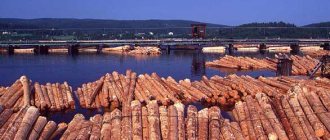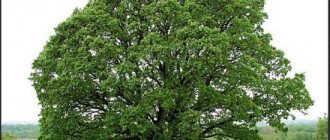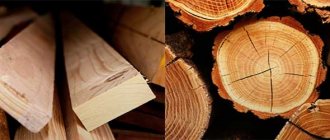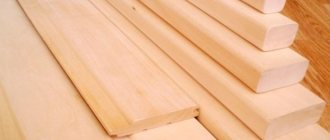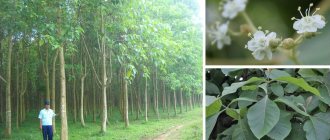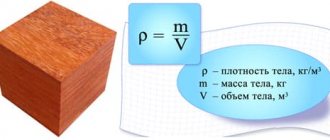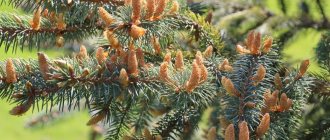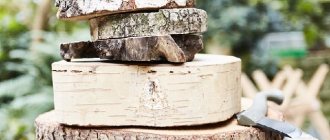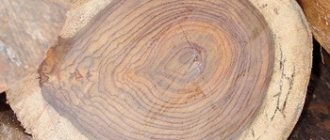Yarra Amazonian
This tree is highly durable - 6 points according to Brinnell.
It can be found exclusively in South America. A distinctive feature of Amazonian yarra is that when it is cut, the wood darkens. This happens as a result of high humidity. The boards made from it are flexible and cannot be sanded perfectly. More often, such wood is used to create boats, some interior items, and souvenirs.
What is made from hardwood?
Hardwoods have many uses, depending on the species. So, canes, billiard cues, furniture, and parquet are made from Brazilian cherry, which is called jatoba. But this wood is not used in shipbuilding, as it deteriorates in sea water.
Brazilian cherry parquet and furniture
Acacia wood has a yellow tint. It was also known to cabinetmakers because it does not rot or wear out. Parquet is made from acacia wood, which is considered stronger than oak, and it becomes more beautiful over the years.
Marbau wood, due to its increased hardness, is used in the construction of public buildings, and is also used to make parquet. It is used when decorating wet rooms, as it is not afraid of water.
Marbau wood is not only very durable, but also moisture resistant
Previously, durable ash wood was used to make not only hunting tools, but also military weapons, spears and clubs. It is known that when beech wood is steamed, it bends easily. This property is indispensable in the manufacture of round-shaped furniture, including Viennese chairs. Beech is used to make gun butts, weaving shuttles and even musical instruments. In addition, plywood and containers are made from beech, beech parquet and measuring instruments are known.
Sucupira
This type of wood is easily distinguished by texture and shade. The interior is dominated by reddish-brown inclusions with light yellow veins.
Quite a practical tree, but difficult to process. However, it can be polished and sanded well. Brinnell hardness - 5.6 points.
Due to the oiliness of wood, it is not susceptible to the negative effects of parasites and tree fungi.
The hardest woods
Based on the hardness data obtained, a list of the hardest trees has been compiled. It included white acacia. This tree grows in large quantities in Europe, where it came from North America.
White acacia is included in the rating of the most durable trees
Brazilian cherry, scientifically called jatoba, is second in hardness. It should be noted that this tree has nothing in common with plants of the “cherry” genus. Sucupira grows in South America. Its wood is not only practical, but also decorative, as it has interspersed light veins that contrast with the reddish-brown wood. It is known that fungi and pests are not terrible in sucupira. Despite the fact that wood is difficult to process, it can be sanded well.
Brazilian cherry is not only durable, but also a beautiful tree.
There is such a hard wood as African mutania. The unusual thing is that its structure is similar to teak, and its color resembles walnut. In Central America there is the amaranth tree, which has dense but flexible wood with a red-violet hue and a large, expressive structure. Amaranth is difficult to process and varnish, however, individual accessories and expensive furniture are made from its wood.
Durable amaranth tree has an unusual color
Merbaye is another type of hardwood. It is easy to process, easy to polish and resistant to moisture. These properties make it ideal for the production of parquet and bathroom decoration. The well-known Canadian maple, growing in North America, is also called sugar maple. This solid tree is a symbol of Canada.
Yarra is an Australian eucalyptus. Due to the similarity of its wood to mahogany, the tree is also called Australian mahogany. Rosewood wood is considered hard. His homeland is Brazil. It is an indispensable material for the manufacture of musical instruments and furniture for presentable objects.
Oak has strong and beautiful wood
Next on the list is ash, which is a very hard wood, followed by oak, which is a heavy, durable wood. It is impossible not to say about beech. The properties of its wood allow it to be widely used.
Balau (bingkirai)
Hardness index - 5.1 Brinell points. It grows exclusively in Southeast Asia. Due to its strength and performance characteristics, it is often used as a decking board, bathroom flooring and to create garden furniture.
A distinctive feature is that this type of wood is practically not susceptible to rotting.
Temir-agach
This hardest tree is present in the forests of Azerbaijan and Iran. In terms of hardness, it is many times stronger than iron. If you want to walk through thickets of such trees, you will very soon realize that this is impossible due to the lack of flexibility of their trunks. Very often, such trees are used to make hedges, which grow stronger and stronger every year.
Nut
Walnut is a wood that is mostly used for decorative finishing indoors, as well as for creating interior items and furniture fittings.
This type of wood is easy to process, but does not deform and is highly resistant to cracking during wood drying. Brinell hardness is 5 points.
Parrotia
This is the hardest tree among the “iron” ones and is found in the forests of Northern Ireland and Transcaucasia. The black wood has an unusual structure, is very durable and is resistant to various insect pests. Due to the high density of parrotia wood, it is successfully used for the production of wind musical instruments, machine parts and various artistic crafts. This tree is included in the Red Book.
This representative of the “iron” trees not only has super-strong wood, but also does not rot, which is why it received the name “non-iron tree”. Found in Transcaucasia and the Far East. In the past, the wood of the “slender wood” was used to make nails and was also used to build structures located under water or underground.
Merbau
More often it can be found in Asia, New Guinea and Papua. The average height of an adult tree is 30 meters, but its weight can reach 800 km per cubic meter. It is so heavy because of its high density. Hardness index - 4.9 points.
Initially, the color of the wood ranges from yellow to light orange, but some time after cutting it begins to darken and acquire a brown tint with a silver or bronze tint.
The densest trees in the world
Keep in mind that wood density can vary by an average of plus or minus 10%. So it's entirely possible that the tenth-ranked sample on this list could easily weigh more than the first-place sample. Moreover, some of these types of wood weigh on average only a few tenths more kg/m3 than their closest rivals.
It’s interesting, but all types of wood have a density above 1000 kilograms per cubic meter, which means that a raft with such wood will not float :-). All of the wood listed below is heavier than water and sinks easily. The density is calculated for a humidity of 12%.
Jatoba, a variety of mahogany - 10th place.
- The density of Jatoba wood is slightly above 1000 kg/m3.
The Mopane tree is in ninth place.
- The density of Mopane wood reaches 1200 kg per cubic meter. This is an African wood that is quite difficult to process, but its advantage is its good acoustic properties, which is why it is often used in musical instruments.
Lead tree - 8th place.
- Leadwood (Combretum imberbe) or South African tree, translated means lead tree. It is quite rare even in Africa, therefore it is under the protection of the authorities. The density of this tree is about 1235 kg per cubic meter.
Quebracho “broken axe” – 7th place.
- The Quebracho tree is native to South America and means “broken axe” in Spanish. Wood is very difficult to process. Density is about 1250 kg per cubic meter.
6th place - snake tree.
- Snakewood - snakewood, density 1270 kilograms per cubic meter. The structure of the tree resembles the skin of a snake. Surprisingly, the height of this tree is no more than three meters. The tree is common in Central America. Because of its unique structure, the tree is highly valued and is one of the most expensive and sought after in the world. Difficult to process.
Olneya tesota - 5th place.
- Olneya tesota is one of the varieties of ironwood. The density of this tree is about 1275 kg/m3. This is a fairly drought-resistant tree.
- Krugiodendron ferreum - 4th place, the density of this wood is 1300 kg per cubic meter. This tree can very rarely be found on sale, since it is very small in size and lumber cannot be obtained from it; the height of the tree is about 5 - 7 meters.
Bulnesia Arborea - 3rd place!
- This tree is often called Argentine ironwood. Density 1300 kilograms per cubic meter.
Second place is Dalbergia melanoxylon or African Ebony.
- African ebony - 2nd place. Density 1310 kilograms.
So, the winner is recognized all over the world - Iron Tree.
- Guaiacum officinale - ironwood, this tree is recognized as the heaviest in the world. Ironwood wood is listed as an endangered species and is listed in CITES (the International Convention for the Protection of Endangered Wildlife and Fauna). The density of this tree is 1352 kilograms per cubic meter of wood.
Bilinga
Grows in equatorial Africa. Wood contains a large amount of natural oils and tannins. Due to this, it is resistant to rotting, the negative effects of parasites, and moisture. Brinnell hardness - 4.5 points.
It is mainly used to create furniture and parquet, as it has high wear resistance due to its strength.
Wenge
Heavy, smooth-grained and large breed. Processing wenge is difficult, since the wood cannot be bent. Also, varnishing wood is not an easy task, this is due to the fact that the pores of wood contain a large amount of oily and mineral substances. Hardness index - 4.2 points.
Each of the wood species included in my top 10 has high hardness and is suitable for creating furniture, parquet boards and other things. In addition to this characteristic, almost all of them are characterized by high wear resistance and resistance to pests.
Dogwood
The wood of this tree, which grows up to 8 meters, was previously used to produce parts for watches, buttons, gun cleaning rods, and parts for weaving machines. And spears or arrows, which were made from dogwood wood, did not wear out.
This Bornean “iron” wood is extremely difficult to process due to the high hardness of the wood. Its smooth texture and pleasant color make ulin especially attractive in the production of parquet, solid boards and furniture. You can cut this tree, but you often have to sharpen your tools. But a product made from ulin will last quite a long time.


